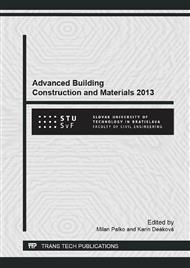p.145
p.149
p.154
p.160
p.164
p.171
p.175
p.181
p.187
Applied Aerodynamics in Building
Abstract:
Development of new materials, high strength concrete, steels, composites, new construction techniques and procedures put the Development of new materials, high strength concrete, steels, composites, new construction techniques and procedures put the foundations of a new generation of buildings. With the advent of advanced computer technology, using the finite element method engineers and architects plan and construct buildings that are, high, flexible, thin and lightweight. These buildings, however, are burdened by aerodynamic forces, whose source is wind. Just the action of aerodynamic forces adversely affects their ability to traffic, reducing safety and durability. It is therefore necessary to provide high flexibility structures and maintain their safety. This can only be achieved by means of applied aerodynamics using various types of passive and active components to optimize aerodynamics of buildings.
Info:
Periodical:
Pages:
164-167
Citation:
Online since:
December 2013
Authors:
Price:
Сopyright:
© 2014 Trans Tech Publications Ltd. All Rights Reserved
Share:
Citation:


